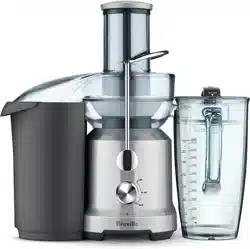Documents: Go to download!
- Owner's manual - (English, French)
- Components
- Care & Cleaning
- Troubleshooting
- TIP
- Assembly
- Functions
Table of contents
User Manual Juice
Components
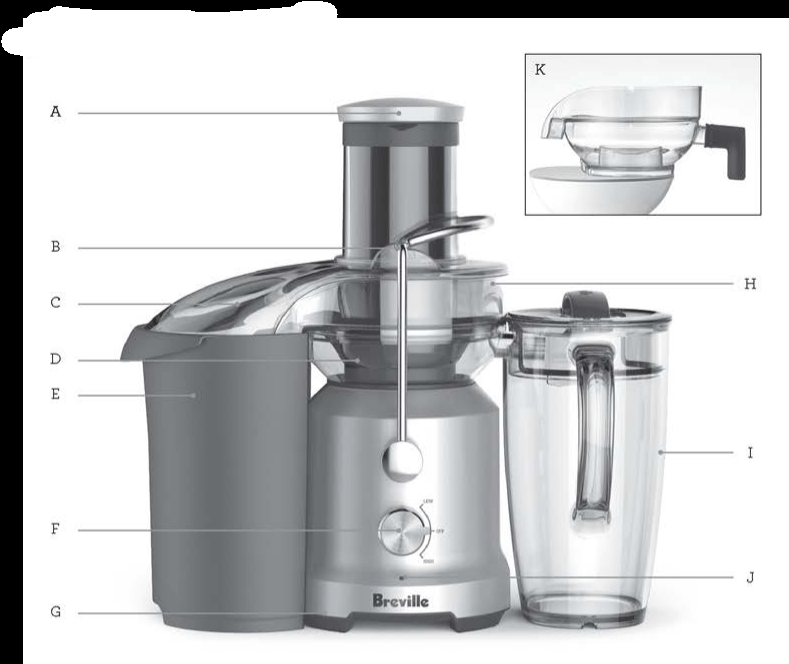
A. Food pusher
(top shelf dishwasher safe)
B. Interlocking safety arm
Stops juicer operating without cover locked into place.
C. Juicer cover
(not dishwasher safe)
D. Stainless steel filter basket
(top shelf dishwasher safe)
E. Pulp container
(top shelf dishwasher safe)
F. 2 speed control and off dial
G. Cord storage
Cord wraps around feet and clips into position under base.
H. Filter bowl surround
(top shelf dishwasher safe)
I. 70 fl. oz. (2 liter) juice jug and sealing lid with built in froth separator
(not dishwasher safe).
J. Overload Protection LED
K. Juicing Nozzle
(top shelf dishwasher safe)
Can be placed over spout to juice directly into a cup.
Care & Cleaning
Ensure the juicer is turned off by turning the juicer dial to the OFF position. Then unplug the power cord.
CLEANING
Rinse all parts after use (except the motor base) under running water to clear away the majority of juice and pulp. Wash in warm soapy water with a soft cloth.
To avoid food diying on to the blades, mesh or transparent parts, rinse and wash as soon as possible after use.
PULP CONTAINER
To minimize cleaning, you can line the pulp container with a biodegradable bag to collect the pulp.
MOTOR BASE
To clean the motor base, wipe with a soft, damp cloth then dry thoroughly. Wipe any excess food particles from the power cord. Do not immerse the motor base in liquids.
CLEANING AGENTS
Do not use abrasive scouring pads or cleaners on either the motor base or the jug, as they may scratch the surface. Use only warm soapy water with a soft cloth.
DISHWASHER
Wash all parts (except the motor base) in warm soapy water with a soft cloth.
The filter bowl surround, stainless steel filter basket, food pusher and pulp container are dishwasher safe. Wash on a standard cycle, on the top shelf only.
The juice cover and juice jug are not dishwasher safe.
FILTER BASKET
To ensure consistent juicing results, always clean the filter basket thoroughly immediately after use.
If pulp is left to dry, it may clog the fine pores of the filter mesh, which can effect juicing performance. The filter basket can be soaked in hot soapy water for 10 minutes, if necessary.
Hold the filter basket under running water and use brush (supplied with the juicer) in a circular motion to clear away pulp from the inside of the basket, including the blades. Turn over to brush away pulp from the outside of the basket, and repeat if necessary.
After cleaning, hold up towards a light source to check that the fine mesh pores are not blocked. If blocked, soak the filter basket in hot water with 10% lemon juice to loosen, and brush under running water again.
Do not soak the filter basket in bleach, harsh chemicals or abrasive cleansers.
Always treat the filter basket with care, as it can be easily damaged. Do not use if there is any damage or deformation to the filter mesh.
Filter basket can be washed in the dishwasher (top shelf).
The center of the filter basket has an array of small, sharp blades. Do not touch these blades when handling the filter basket.
STUBBORN FOOD STAINS
Discoloration of the plastic may occur with strongly colored fruit and vegetables. To help prevent this, wash parts immediately after use.
If discoloration does occur, the plastic parts can be soaked in water with 10% lemon juice or can be cleaned with a non-abrasive cleaner.
Troubleshooting
Juicer will not work when switched ON
- The safety locking arm may not be correctly engaged in the vertical operating position. Check the top cover is properly aligned and the locking arm is located firmly into the two grooves on either side of the juicer cover.
- Motor overload protection may have operated (see below).
Overheating with excessive loads
- The juicer is equipped with an internal self-resetting overload to prevent the motor from damage under heavy or continuous loads. If the motor suddenly stops working, turn the dial to OFF. and unplug the unit from the power outlet. Allow the juicer to cool for up to 30 minutes before operating again.
- NOTE: The unit MUST be unplugged from the power outlet in order for it to cool and be reset.
- Despite this overload protector, we suggest juicing in smaller batches, without excessive pushing force, to avoid overheating and stalling and to maintain the life of the motor.
Excess pulp building up in the stainless steel filter basket
- Stop juicing, disassemble to scoop excess pulp off the juicer cover. Reassemble and continue juicing. Alternating soft and hard ingredients may help avoid this.
Pulp too wet and reduced extracted juice
- The cleaner the filter, the better the juice yield, and dryer the pulp. Be sure to thoroughly clean the juicer as soon as possible after each use. Remove the stainless steel filter basket and thoroughly clean mesh walls with a cleaning brush. Rinse the filter basket under hot water. If the fine mesh holes are blocked, soak the basket in a solution of hot water with 10% lemon juice to unlock the holes or wash in the dishwasher (top shelf). This will remove excess fiber build up (from fruit and vegetables) which could be inhibiting the flow.
Juice leaks between the rim of the juicer and the juicer cover
- Try a slower juicing speed and push the food pusher down the feed chute more slowly.
Juice sprays out from spout
- The juice is being extracted too fast: try a slower juicing speed (if possible) and push the food pusher down the feed chute more slowly.
Motor appears to stall when overload protection LED flashes
- Wet pulp can build up under the juicer cover and stall the juicer if the juicer is used excessively without cleaning. If this occurs, disassemble and follow the cleaning instructions to clean the filter bowl surround, the stainless steel Alter basket and the juicer cover. The juicer can also stall if excessive force is used to push produce down the feed chute. If this occurs, ensure that a more gentle pressure is used to push produce down the chute.
- The juicer will automatically stop operating if either too much food is being processed at one time or the pieces are not small enough. Try trimming the food or cutting into smaller pieces of even size and processing a smaller amount per batch. To continue juicing, reset the juicer by turning the juicer OFF and back ON.
- Allow the motor to reach full speed before putting ingredients in the chute. Pressing ingredients down before the juicer reaches full speed can cause the motor to stall or overload. Use gentle to moderate pressure on the pusher. Lower pressure produces a better juice yield.
- Hard fruit and vegetables will put excess strain onto the motor if a low speed is selected. Refer to the juicing guide to determine the correct speed for the fruit and vegetables selected for juicing.
Overload protection LED light flashing during the use
- This indicates the motor speed is slowed down to a not-efficient level. This may be caused by too heavy pushing force on the pusher or too much pulps sticking onto the lid or in pulp pin. Using proper pushing force on the food pusher or regularly clean the lid and pulp bin can prevent this situation to happen.
Overload Protection LED is on
- This indicates motor overload protection is activated. To reset the unit, unplug the unit from power and let the motor cool down for 10 to 15 minutes, and plug the power on again.
If any of the above issues persist, or if you have questions, stop use of the juicer and contact Breville Consumer Support.
TIP
THE INSIDE INFORMATION ON JUICING
Fresh fruit and vegetable juices are an excellent source of vitamins and minerals.
When you make your own fruit and vegetable juices, you have complete control over what is included.
Refer to juicingscience.com for additional nutritional and fiber information on green juices and green smoothies.
PREPARATION OF FRUITS AND VEGETABLES
Fruits with hard or inedible skins should be peeled before juicing, including mangoes, guavas, melons, etc.
Some vegetables, such as cucumbers can be processed unpeeled depending on the softness of the skin and whether you like the taste of the skin in your juice.
Fruits with hard seeds or pits must be pitted before juicing, including nectarines, peaches, mangoes, plums, cherries, as the skin and pith can make the juice bitter. Citrus fruits with thick pith or skin should be peeled before juicing, including oranges, lemons, mandarins, etc.
Trim leaves and wash vegetables to remove earth/soil, including carrots, beet, spinach, etc.
Trim, hull and remove stalks before juicing, including strawberries, apples, pears, etc.
A small amount of lemon juice can be added to apple juice to reduce browning.
THE RIGHT TECHNIQUE
When juicing a variety of ingredients with varying textures, start with the softer texture ingredients on the LOW speed and then gradually change to the HIGH speed for the harder textured ingredients.
If you are juicing herbs, sprouts or other leafy green vegetables, either wrap them together to form a bundle and alternate with more solid ingredients for the best extraction.
Fruits and vegetables produce different amounts of liquids, and can vary between batches or at different times of year. Juice recipes are not exact, so therefore the precise quantities of any juice are not crucial to the success of a particular mixture.
To extract the maximum amount of juice always push the food pusher down slowly. Allow the motor to reach full speed before putting ingredients in the chute. Pressing ingredients down before the juicer reaches full speed can cause the motor to stall or overload. Use gentle to moderate pressure on the plunger. Lower pressure produces a better juice yield.
USING THE PULP
The remaining pulp left after juicing fruit and vegetables is mostly fiber and cellulose which, like the nutrients in juice, are necessary for the daily diet and can be used in many ways. However, like the juice, pulp should be used that day to avoid loss of vitamins. There are a number of recipes contained in this book that show the ways in which juice pulp can be used. Apart from these, pulp can also be used to add bulk to rissole mixtures, thicken casseroles or soups.
Fruit pulp can be placed in a heat proof bowl, topped with meringue, and baked in the oven for a simple dessert.
When using the pulp, there may be some pieces of fruit or vegetables remaining These should be removed before using the pulp in any recipes.
Apart from consumption use, pulp can also be used to create compost for the garden.
Assembly
BEFORE FIRST USE
Before using your juicer for the first time, remove and safely discard any packaging materials and promotional stickers and labels.
Ensure the power cord is unplugged.
Wash the filter bowl surround, filter basket, juicer cover, food pusher, pulp container and juice jug and lid in warm, soapy water with a soft cloth. Rinse and diy thoroughly.
1. Place motor base on a flat, dry surface such as a countertop. Ensure that the juicer is switched to OFF at the dial, and the power cord is unplugged.
2. Place filter bowl surround on top of the motor base.

3. Align the arrows at the base of the stainless steel filter basket with the arrows on the motor drive coupling and push down until it clicks into place to create a secure fit with the motor base.

4. Place the juicer cover over the filter bowl surround, positioning the lower part of the feed chute over the stainless steel filter basket

5. Raise the safety locking arm up and locate into the two grooves on either side of the juice cover.
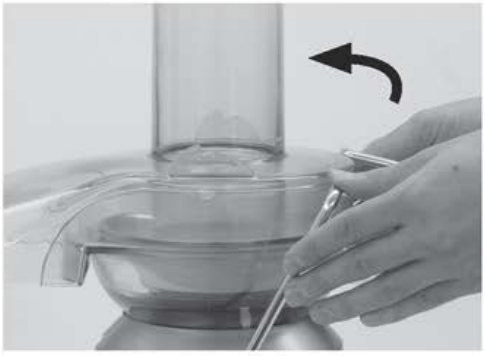
6. The safety locking arm should now be in a vertical position and locked into place on top of the juice cover.
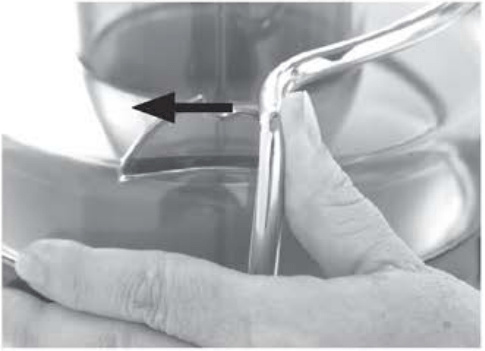
7. Slide the food pusher down the food chute by-aligning the groove in the food pusher, with the small protrusion on the inside of the top of the feed tube.
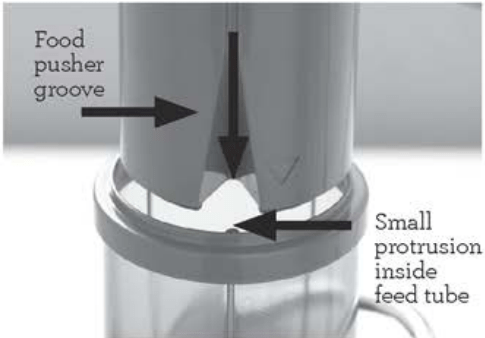
8. Place the pulp container into position by tilting and lifting the motor base slightly. Insert the pulp container under the juicer cover on the left hand side ensuring it is supported by the juicer cover and motor base.
9. Place the juicer jug under the juice spout and place the lid to avoid splatter.
JUICE JUG
Juice can be preserved in the juice jug for up to 3 days by following these steps.

1. Lift the lid off the jug and rotate 180°
2. Press down firmly to replace the lid
3. Store juice in the fridge
Storage time depends on the ingredients being juiced and the freshness of the fruit prior to juicing. Juice must be stored in the refrigerator between 32°F to 39°F.
Functions
1. Wash your selection of fruit and vegetables to be juiced. Most fruit and vegetables such as apples, carrots and cucumbers will not need to be cut or trimmed to size as these will ht whole into the feed chute. Ensure vegetables such as beets, carrots etc. have all soil removed, are washed well and trimmed of leaves before using.
2. Plug the power cord into a 120V power outlet. Adjust the speed to the desired setting. Turn the dial to either the LOW or HIGH setting depending on the type of fruit or vegetable being juiced. Use the speed selector as a guide for juicing different fruits and vegetables.
3. With the motor running, place food into the feed chute and use the food pusher to gently guide food down. To extract the maximum amount of juice, always push the food pusher down slowly.
4. As fruit and vegetables are processed, juice will flow into the juice jug and the separated pulp will accumulate in the pulp container.
SPEED SELECTOR GUIDE
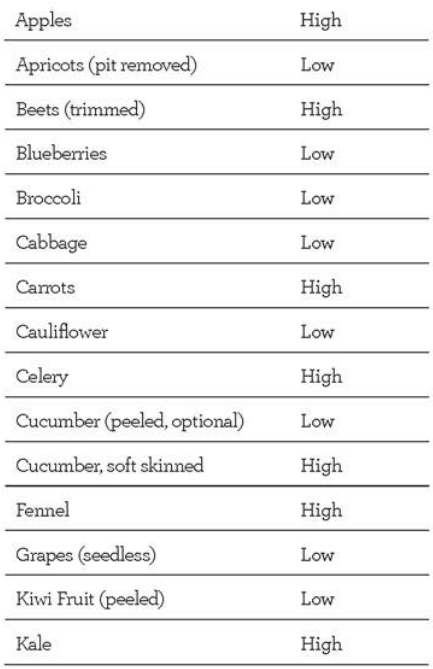

NOTE
The pulp container can be emptied during juicing by turning the juicer OFF on the dial and then carefully removing the pulp container. Replace empty pulp container before continuing to juice.
Do not allow the pulp container to overfill as this may affect the operation of the appliance. The juicer is fitted with a safety device which safeguards against overheating with excessive loads. If overheating occurs, the juicer will automatically activate the overload protection device and the unit will switch itself off. When the overload protection is activated, unplug the juicer from the power outlet for at least 15 minutes to allow the unit to cool. Then plug juicer into the power outlet and use as normal.
WARNING
Never use fingers, hands or utensils to push food down the feed chute or to clear the feed chute. Always use the food pusher provided.
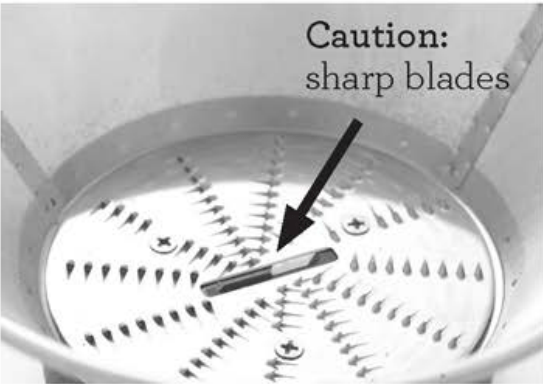
The stainless steel filter basket contains small sharp blades to cut and process fruit and vegetables. Avoid touching the blades when handling the filter basket.
See other models: BJE520BSS BJE830SIL2JAN1 BJE825BAL BJS700SIL2JAN1 BCP600SIL
